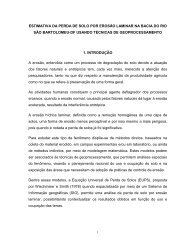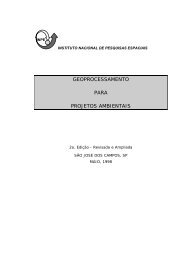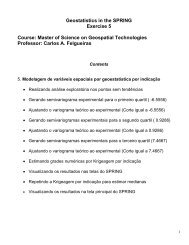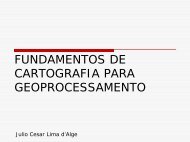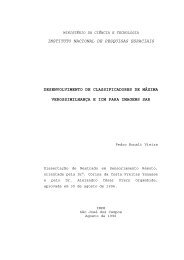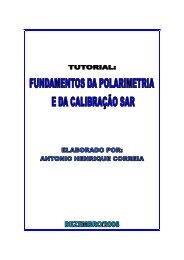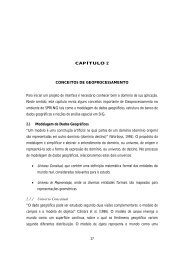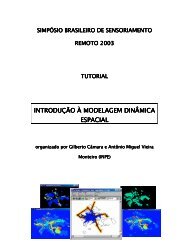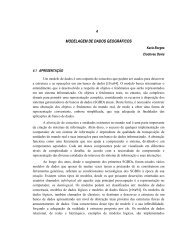HAND, a new terrain descriptor using SRTM-DEM - DPI - Inpe
HAND, a new terrain descriptor using SRTM-DEM - DPI - Inpe
HAND, a new terrain descriptor using SRTM-DEM - DPI - Inpe
Create successful ePaper yourself
Turn your PDF publications into a flip-book with our unique Google optimized e-Paper software.
network be identified by a unique identification number k a N⁎. We<br />
define that<br />
Dðhi; jiÞ<br />
¼<br />
k if hi; ji is a drainage network point<br />
0 otherwise<br />
and its inverse function as<br />
D 1 ðÞ¼ k fhi; jiaGjDðhi; jiÞ<br />
¼ kg:<br />
ð10Þ<br />
Following respective flow paths, each and every point in the grid is<br />
necessarily connected to a drainage point. Let I(hi,ji) be the function<br />
that identifies the drainage point connected to the point hi,ji. This<br />
function is computed through an iterative process and the result is a<br />
grid that associates the identification number of the drainage point<br />
that each point is connected to. If I t (hi,ji) is the drainage identification<br />
number of the point hi, ji in the t th iteration. In the first iteration (t=1),<br />
I 1 ðhi; jiÞ<br />
¼ Dðhi; jiÞ:<br />
ð11Þ<br />
For the other iterations (tN1)<br />
I t I<br />
ðhi; jiÞ<br />
¼<br />
t 1ðhi; jiÞ<br />
if It 1ðhi; jiÞp0<br />
It 1ðFðhi; jiÞÞ<br />
if It 1 8<br />
<<br />
:<br />
0<br />
ðFðhi; jiÞÞp0<br />
otherwise:<br />
ð9Þ<br />
ð12Þ<br />
The iteration process stops (t=m) when, for any point hi,ji, I t (hi,ji)≠0,<br />
that is,<br />
Iðhi; jiÞ<br />
¼ I m ðhi; jiÞ:<br />
ð13Þ<br />
Assuming that all points belong to a flow path and that all flow<br />
paths are associated to respective drainage points, we define the<br />
<strong>HAND</strong> value of any given point hi, ji as<br />
<strong>HAND</strong>ðhi; jiÞ<br />
¼<br />
H hi; ji ð Þ HDðhi; jiÞ<br />
if HDðhi; jiÞbHðhi;<br />
jiÞ<br />
0 otherwise<br />
ARTICLE IN PRESS<br />
C.D. Rennó et al. / Remote Sensing of Environment xxx (2008) xxx-xxx<br />
Fig. 3. Procedure to calculate the <strong>HAND</strong> grid. BBBBlue squares represent grid points belonging to the drainage network. Only black arrows are considered as flow paths.<br />
ð14Þ<br />
where H(hi,ji) represents the height of the point hi, ji given by the<br />
original <strong>DEM</strong> and H D(hi, ji) is the height of drainage point hydrologically<br />
connected to point hi,ji following the flow path, that is,<br />
HDðhi; jiÞ<br />
¼ HD 1 ðIðhi; jiÞÞ<br />
: ð15Þ<br />
It is important to note that if the point i,j is a point belonging to<br />
the drainage, then<br />
Iðhi; jiÞ<br />
¼ Dðhi; jiÞ<br />
ð16Þ<br />
D 1 ðIhi; jiÞ<br />
¼ hi; ji ð17Þ<br />
HDðhi; jiÞ<br />
¼ Hðhi; jiÞ<br />
ð18Þ<br />
and so<br />
<strong>HAND</strong>ðhi; jiÞ<br />
¼ Hðhi; jiÞ<br />
Hðhi; jiÞ<br />
¼ 0: ð19Þ<br />
In other words, all grid points belonging to the drainage network<br />
are zeroed in height, which implies that the draining potential<br />
(according with the <strong>HAND</strong> definition) along the stream channel is<br />
disregarded. Although the drainage channel is also a flow path, which<br />
effectively drains, the <strong>HAND</strong> <strong>descriptor</strong> uses the whole channel as a<br />
flat relative topographic reference, the end of all non channel flow<br />
paths. By definition, the <strong>HAND</strong> drainage outlet grid point is the nearest<br />
draining point to itself, therefore it can only be subtracted from itself.<br />
It is important to note that the breaching process, required to reach a<br />
topologically sound and accurate drainage network, introduces occasional<br />
canyon like artifacts into the <strong>DEM</strong>, as a result of aberrant height<br />
differences adjacent to the drainage network. These artifacts would be<br />
transferred to the <strong>HAND</strong> grid if it were computed from the corrected<br />
<strong>DEM</strong>. When <strong>using</strong> original <strong>SRTM</strong> data for the <strong>HAND</strong> grid computation,<br />
some associations prescribed by the corrected drainage connection grid<br />
result in small negative differences that could be interpreted as points<br />
Please cite this article as: Rennó, C. D., et al., <strong>HAND</strong>, a <strong>new</strong> <strong>terrain</strong> <strong>descriptor</strong> <strong>using</strong> <strong>SRTM</strong>-<strong>DEM</strong>: Mapping terra-firme rainforest environments<br />
in Amazonia, Remote Sensing of Environment (2008), doi:10.1016/j.rse.2008.03.018<br />
5



